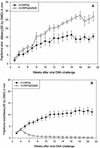Amino acid residues in the carboxy-terminal region of cottontail rabbit papillomavirus E6 influence spontaneous regression of cutaneous papillomas
- PMID: 12414922
- PMCID: PMC136889
- DOI: 10.1128/jvi.76.23.11801-11808.2002
Amino acid residues in the carboxy-terminal region of cottontail rabbit papillomavirus E6 influence spontaneous regression of cutaneous papillomas
Abstract
Previous studies have identified two different strains of cottontail rabbit papillomavirus (CRPV) that differ by approximately 5% in base pair sequence and that perform quite differently when used to challenge New Zealand White (NZW) rabbit skin. One strain caused persistent lesions (progressor strain), and the other induced papillomas that spontaneously regressed (regressor strain) at high frequencies (J. Salmon, M. Nonnenmacher, S. Caze, P. Flamant, O. Croissant, G. Orth, and F. Breitburd, J. Virol. 74:10766-10777, 2000; J. Salmon, N. Ramoz, P. Cassonnet, G. Orth, and F. Breitburd, Virology 235:228-234, 1997). We generated a panel of CRPV genomes that contained chimeric and mutant progressor and regressor strain E6 genes and assessed the outcome upon infection of both outbred and EIII/JC inbred NZW rabbits. The carboxy-terminal 77-amino-acid region of the regressor CRPV strain E6, which contained 15 amino acid residues that are different from those of the equivalent region of the persistent CRPV strain E6, played a dominant role in the conversion of the persistent CRPV strain to one showing high rates of spontaneous regressions. In addition, a single amino acid change (G252E) in the E6 protein of the CRPV progressor strain led to high frequencies of spontaneous regressions in inbred rabbits. These observations imply that small changes in the amino acid sequences of papillomavirus proteins can dramatically impact the outcome of natural host immune responses to these viral infections. The data imply that intrastrain differences between separate isolates of a single papillomavirus type (such as human papillomavirus type 16) may contribute to a collective variability in host immune responses in outbred human populations.
Figures







Similar articles
-
Large cutaneous rabbit papillomas that persist during cyclosporin A treatment can regress spontaneously after cessation of immunosuppression.J Gen Virol. 2005 Jan;86(Pt 1):55-63. doi: 10.1099/vir.0.80448-0. J Gen Virol. 2005. PMID: 15604431
-
Increased immunity to cottontail rabbit papillomavirus infection in EIII/JC inbred rabbits after vaccination with a mutant E6 that correlates with spontaneous regression.Viral Immunol. 2007 Summer;20(2):320-5. doi: 10.1089/vim.2006.0104. Viral Immunol. 2007. PMID: 17603848
-
Ubiquitin-fused and/or multiple early genes from cottontail rabbit papillomavirus as DNA vaccines.J Virol. 2002 Aug;76(15):7616-24. doi: 10.1128/jvi.76.15.7616-7624.2002. J Virol. 2002. PMID: 12097575 Free PMC article.
-
The rabbit viral skin papillomas and carcinomas: a model for the immunogenetics of HPV-associated carcinogenesis.Clin Dermatol. 1997 Mar-Apr;15(2):237-47. doi: 10.1016/s0738-081x(97)00009-6. Clin Dermatol. 1997. PMID: 9167908 Review. No abstract available.
-
Cottontail rabbit papillomavirus (CRPV) model system to test antiviral and immunotherapeutic strategies.Antivir Chem Chemother. 2005;16(6):355-62. doi: 10.1177/095632020501600602. Antivir Chem Chemother. 2005. PMID: 16331841 Review.
Cited by
-
The rabbit papillomavirus model: a valuable tool to study viral-host interactions.Philos Trans R Soc Lond B Biol Sci. 2019 May 27;374(1773):20180294. doi: 10.1098/rstb.2018.0294. Philos Trans R Soc Lond B Biol Sci. 2019. PMID: 30955485 Free PMC article. Review.
-
Papillomavirus DNA complementation in vivo.Virus Res. 2009 Sep;144(1-2):117-22. doi: 10.1016/j.virusres.2009.04.006. Epub 2009 Apr 18. Virus Res. 2009. PMID: 19379784 Free PMC article.
-
Modeling HPV-Associated Disease and Cancer Using the Cottontail Rabbit Papillomavirus.Viruses. 2022 Sep 4;14(9):1964. doi: 10.3390/v14091964. Viruses. 2022. PMID: 36146770 Free PMC article. Review.
-
Using HLA-A2.1 Transgenic Rabbit Model to Screen and Characterize New HLA-A2.1 Restricted Epitope DNA Vaccines.J Vaccines Vaccin. 2010 Aug 20;1(1):1000101. doi: 10.4172/2157-7560.1000101. J Vaccines Vaccin. 2010. PMID: 21572916 Free PMC article.
-
Immunologic Control of Mus musculus Papillomavirus Type 1.PLoS Pathog. 2015 Oct 23;11(10):e1005243. doi: 10.1371/journal.ppat.1005243. eCollection 2015 Oct. PLoS Pathog. 2015. PMID: 26495972 Free PMC article.
References
-
- Apple, R. J., H. A. Erlich, W. Klitz, M. M. Manos, T. M. Becker, and C. M. Wheeler. 1994. HLA DR-DQ associations with cervical carcinoma show papillomavirus-type specificity. Nat. Genet. 6:157-162. - PubMed
-
- Beekman, N. J., P. A. van Veelen, T. van Hall, A. Neisig, A. Sijts, M. Camps, P. M. Kloetzel, J. J. Neefjes, C. J. Melief, and F. Ossendorp. 2000. Abrogation of CTL epitope processing by single amino acid substitution flanking the C-terminal proteasome cleavage site. J. Immunol. 164:1898-1905. - PubMed
-
- Beskow, A. H., A. M. Josefsson, and U. B. Gyllensten. 2001. HLA class II alleles associated with infection by HPV16 in cervical cancer in situ. Int. J. Cancer 93:817-822. - PubMed
Publication types
MeSH terms
Substances
Grants and funding
LinkOut - more resources
Full Text Sources

